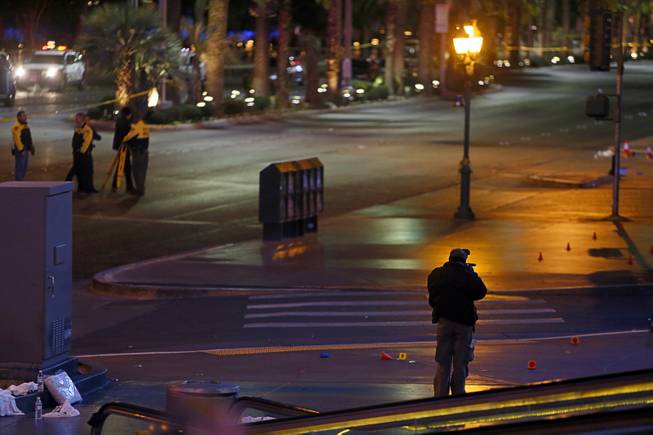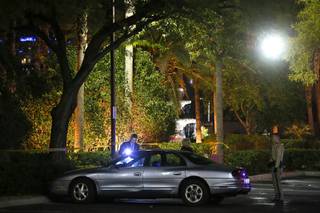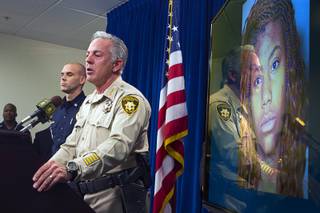
A crime scene analyst takes photos as Las Vegas Metro Police and Nevada Highway Patrol troopers investigate an auto-pedestrian crash Sunday, Dec. 20, 2015, on the Strip that killed one person and injured at least 30 others.
Tuesday, Dec. 22, 2015 | 2 a.m.
More Coverage
After a woman allegedly steered her car onto the sidewalk along the Las Vegas Strip on Sunday, killing one person and injuring 35 more, Clark County and Metro Police officials are emphasizing the need for greater pedestrian safety measures on Las Vegas Boulevard.
The deadly incident occurred along a stretch of the boulevard where the sidewalk is separated from the street only by a curb, not fencing or other barriers. In a news conference Monday, Clark County Sheriff Joe Lombardo said Metro Police officials were in an ongoing discussion to improve traffic and pedestrian safety in the resort corridor, including "our ability to put barricades, barriers and everything else associated with pedestrian traffic."
Are more barriers in the offing, though? Don't make that assumption.
Clark County Commission Chaiman Steve Sisolak said that although the county has added “thousands of feet” of linear fencing between walkways and roads on the Strip and surrounding areas in recent years, he had doubts about fencing and barricades as solutions to pedestrian safety shortcomings. He believes the solution lies in creating wider sidewalks, more pedestrian overpasses and fewer obstacles for those walking along the Strip.
“People always ask about that, and ask why we’re not putting up more (barriers) along the roads,” he said. "But imagine if there are 50 people in a crosswalk. Someone who wants to use a vehicle as a weapon is going to find a way to wreak incredible amounts of havoc and cause death.”
The county and Nevada Transportation Department announced in June plans to update the four pedestrian bridges at Las Vegas Boulevard and Tropicana Avenue, connecting MGM Grand, Tropicana, New York-New York and Excalibur. The upgrades, scheduled to be completed in 2017, will cost $26 million.
Sisolak has also overseen a $5 million county walkway expansion on the valley’s premier tourist boulevard.
A 2012 county report found 58 of the Strip’s 340 walkway areas from Russell Road to Sahara Avenue with level of service grades of D or worse, on a grading scale from A to F. Such grades mean pedestrians have an average of five to 15 square feet of walking space, leaving them especially vulnerable in case of an emergency.
“It’s something we thought was necessary to address as soon as possible,” Sisolak said.
Three years later, a 2015 updated report said 17 of the low-rated Strip walkway areas had been expanded, allowing pedestrians at least 15 square feet of walking space.
A 2015 updated version of the report also noted a double-digit percent increase in number of “non-permanent obstructions,” like buskers, handbillers and street vendors, on holiday Saturdays since 2012. Such obstructions disrupt pedestrian traffic flow, Sisolak said, and ultimately shift moving pedestrians closer to the road.
“When such obstructions get excessive, they negate all of the work we’ve done to improve the pedestrian flow,” Sisolak explained.
Erin Breen, director of the NDOT-funded Vulnerable Road Users Project and staffed researcher at UNLV’s Transportation Research Center, agreed, adding that pedestrian safety on the Strip under normal circumstances “is not an issue.”
“There’s no engineering for drunks, and there’s certainly no improvements for someone who chooses to ram people on the sidewalks,” Breen said. “Barricading the sidewalks woudn’t stop them, and it wouldn’t fit on the Strip.”
“When people die on the Strip, it’s almost always related to a crime,” Breen added.
Breen, who specializes in pedestrian safety research, said more crosswalks and wider walkways were the answers to making the Strip safer for pedestrians. Lining the sidewalks with pylons or fencing wouldn't guarantee prevention of injuries or even deaths, she said.
"It’s not a fix, because of the speeds the cars travel in our town," Breen said. "It’s like a physics lesson. If a car is traveling 45 mph and hits a barrier, it would literally cause pieces of your car to be projectiles in a forward motion that would have an impact like a gun."
Authorities said the woman accused in Sunday's incident, 24-year-old Lakeisha N. Holloway, intentionally steered a 1996 Oldsmobile sedan onto the sidewalk near Planet Hollywood, Paris Las Vegas and Bally's. Lombardo said Monday that officials were still trying to uncover why Holloway plowed into the pedestrians.
Holloway was arrested on suspicion of open murder and other charges at the Tuscany Suites and Casino near Koval Lane and Flamingo Road after driving there and telling a valet attendant that she had struck pedestrians on the Strip.
Speaking with the Sun on Monday, Metro spokesman Officer Michael Rodriguez said the unpredictable nature of Sunday’s crash made it difficult for the pedestrian victims to protect themselves.
“Those situations are hard to predict and nearly impossible to prevent,” Rodriguez said. “There’s really not a lot you can do.”
Sunday’s tragedy wasn’t the first of its kind on the Las Vegas Strip.
On Sep. 21, 2005, Stephen Michael Ressa, then 27, intentionally drove a stolen Buick sedan onto the sidewalk near Bally's, killing three people and injuring 11 others. He was arrested after he crashed the car into a concrete barrier. Ressa pleaded guilty in 2007 and was sentenced to 100 years in prison.



Join the Discussion:
Check this out for a full explanation of our conversion to the LiveFyre commenting system and instructions on how to sign up for an account.
Full comments policy